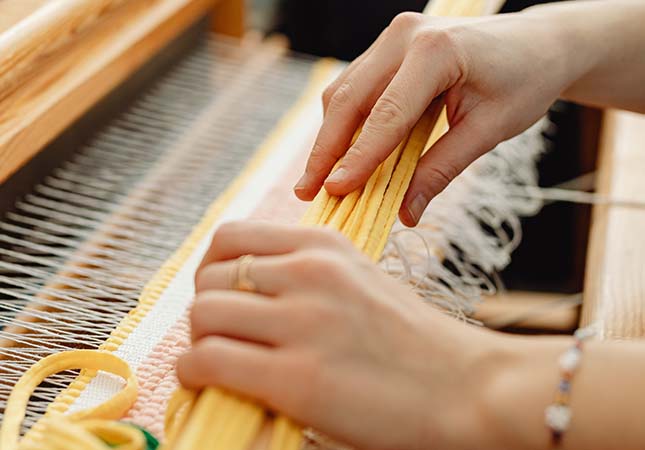A loom machine, the original moniker for a weaving apparatus, is an intricately designed mechanism that facilitates the interweaving of weft threads to produce tapestry and cloth. The crux of its operation relies on its ability to hold warp threads under tension, but the exact shape and structure of each machine varies. A weaving machine, a quintessential tool in textile production, manifests itself in a plethora of types that cater to the distinctive fabric features produced by each variation. Examples of such types include the jacquard weaving machine, the ordinary weaving machine, and the shuttle-less weaving machine.

Weaving, a venerable art that has withstood the test of time for countless centuries, involves the intricate interlacing of two distinct sets of yarn or thread to yield a finished fabric. The term "machine" finds its roots in the ancient English word "geloma," which denotes a "tool." As a general rule, the fundamental framework of a weaving machine consists of a warp beam, heddles, harnesses or shafts, shuttles, reed, and take-up roll. These components seamlessly synchronize to execute the requisite movements essential for the weaving process.
3 Summarized Motions
1. Shedding mechanism
The shedding mechanism is an indispensable component of the weaving machine, primarily responsible for raising the warp yarns and creating a shed. This critical process involves dividing the yarns into upper and lower layers, forming a vertical space that allows the filling yarn carried by the shuttle to be inserted seamlessly, resulting in the formation of the weft. On modern weaving machines, this vital function is executed automatically by a heddle or heald frame, commonly referred to as a harness. Typically, the shedding mechanism features a rectangular frame secured by an array of wires known as healds, through which the yarns are threaded and suspended vertically from the harnesses. The number of harnesses employed when weaving is often determined by the intricacy of the weaving pattern. The two primary methods of controlling heddles are the Jacquard heald and the dobby system.
2. Picking motion
In the weaving process, the filling yarn is deftly interwoven into the fabric via a slender carrier device known as a shuttle, which facilitates the insertion of the yarn through the shed formed by the raised warp yarns. Each end of the shuttle is pointed to aid in the smooth passage of the filling yarn through the shed. The picking motion, a crucial aspect of traditional weaving machines, involves winding the filling yarn onto a quill that is mounted within the shuttle. As the shuttle traverses the width of the loom, the filling yarn is seamlessly threaded through a hole in the shuttle, deftly completing a single crossing, also referred to as a picking motion.
3. Beat-up mechanism
There are primarily two types of beat-up mechanisms in weaving machines: the crank beating-up motion and the conjugate cam mechanism. The former employs a crank and connecting rod to effectuate the forward and backward movements of a sley, deftly completing the beat-up motion. In contrast, the latter relies on a conjugate cam to drive the sley seat in a back-and-forth motion, seamlessly performing the beat-up action. The cam can be custom-designed to regulate the resting time of the sley at the rear, which is especially suited for controlling the weft insertion and beat-up movements. Following the shuttle's traversal across the loom, deftly laying down the filling yarn, the weaver employs a reed to expertly press or batten each filling yarn against the fell, meticulously completing the weaving process.
Shuttle-less Machines
Shuttle-less machines represent a modern weaving technology that obviates the need for a shuttle to produce fabric. These machines offer superior speed and efficiency compared to their traditional shuttle-based counterparts. They are capable of weaving fabric at an astonishing pace of up to 1,000 yards per minute, twice as fast as their shuttle-based counterparts. Moreover, shuttle-less machines reduce the need for operator intervention, resulting in lower labor costs. Furthermore, they generate less waste and have fewer mechanical components, leading to reduced maintenance costs. Overall, shuttle-less machines represent a revolutionary leap in weaving technology, enabling faster, more efficient, and cost-effective production of high-quality fabrics.
SUNTECH Textile Machinery is a distinguished manufacturer of textile machinery with a rich legacy of automation and intelligent manufacturing technology for textile and warehousing equipment. SUNTECH's state-of-the-art core technologies have garnered global recognition.
SUNTECH Textile Machinery has the range of products encompasses almost all fabric types, including but not limited to pinking machine, non-woven machine, beam truck, meltblown machine, fabric cutting machine, motorized beam trolley, beam storage, and fabric inspection machine. SUNTECH Textile Machinery continues to lead the textile industry with its innovative approach and extensive experience. We welcomes quotes and cooperation opportunities with open arms.




